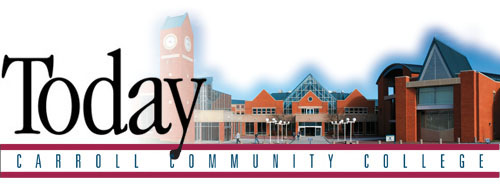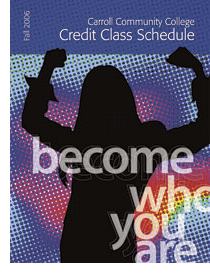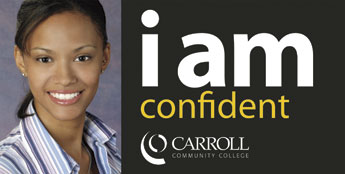
| Convocation 2006, No. 27 |
|
ContentsCollege Launches New Marketing Campaign Bollinger Elected Chair of Board of Trustees Graduate Credits Carroll with her Career Success Graduate Credits Carroll with Introducing Her to Theatre Random House Book Fair Proceeds Benefit Student Scholarships
|
| College Launches New Marketing Campaign |
|
The rhythm is pulsing. Black silhouettes move to the beat, set against an array of bright colors. Dark faces transform into well-defined people, moving in sync with the music. The words “i am” roll onto the screen, followed by the word driven. I am unique. I am ready. The words “become who you are” leap boldly from the screen. What is this visual experience? It’s the new television commercial produced by Carroll Community College. The 30-second spot is part of the college’s new comprehensive, multi-media marketing campaign launched this summer to encourage prospective students to think about Carroll. In marketing lingo, it is a “top-of-mind” awareness campaign.
The commercial is edgy and bold, entertaining and attention-grabbing. It is the flagship component of an integrated campaign which includes billboards, print advertisements for newspapers and magazines, website promotions, and new student orientation materials. Every marketing campaign has a story behind the creation of the concept and the collaboration of the professionals who bring it to life. How was the “i am-become who you are” concept born? At an Emerging Leaders Breakfast hosted by Student Life in 2004, vice president for planning, marketing, and assessment Craig Clagett was seated at a table with several student leaders. He took this opportunity to elicit reactions to a new marketing slogan or “tagline” he had conceived to replace “The Better Freshman Year.” The existing tagline had been introduced in 2000–01 and was scheduled for replacement in 2005–06. “Become who you are” was extremely well received by the student leaders, who represented a wide age range.
The Marketing Communications Advisory Group (MCAG), a committee of college faculty and staff established in September 2002, met several times during the spring of 2005 to explore new marketing concepts for the college. MCAG subcommittees explored the message and media preferences of three generations of students: the Millennials (age 16–23), Gen X (age 24–44), and the Boomers (age 45–62). At this stage, the team was open to both specific generationally-targeted messages and to the possibility of a single tagline that might work across all markets. The MCAG efforts produced numerous message and media ideas for evaluation. Fifteen tagline concepts were tested in two focus groups held in conjunction with new student orientation on August 25, 2005. “Become who you are” was the overwhelming favorite among students in both groups. As one student put it, “When you’re leaving high school, you almost have the feeling that you’re starting anew, and that means becoming who you really are, and not pretending you’re somebody else. I think the slogan fits really well.” In the early winter months of 2006, the college’s Planning, Marketing, and Assessment team met to discuss development and implementation of a broad campaign to raise general awareness of the college among all populations of students. While the phrase “become who you are” had tested well, it was insufficient by itself. The challenge given to the team was to come up with something fresh that would break through all the media images that bombard busy people. With the existing recruitment slogan “The Better Freshman Year” being retired by the college, an entirely new campaign was needed. Graphic designer Peter Anania began thinking about a new strategy over the weekend after the meeting. “When it comes down to it, if students go to college, they open up possibilities about what they can become,” he said. “Students start college thinking ‘I want to be…’ Then when they get their degrees, they reposition that statement into ‘I am….’ Those two simple words were powerful enough for a marketing campaign,” said Anania, who added the research-tested tagline, “Become who you are.” He spent the rest of the weekend working on initial designs, and thought the easy-to-read, easy-to-remember words worked well in his preliminary mock-ups. Back at the college, Anania consulted with his colleagues in Institutional Research. The staff in IR pointed to results of an unusual student research project called “Picture This.” It involved student photography of their impressions of the college. “Picture This” offered insight into what students like. Findings from this project and the previous focus group research suggested that students like to see representations of themselves in advertising. Real stories about real people are what work. This information about student preferences guided the creative direction of the campaign as it blossomed from a TV spot into a multi-media promotion. Identifying student models proved simpler than imagined, as they graciously agreed to be photographed and interviewed for testimonials. A graduate who became a nurse after Carroll, a graduate who attended Johns Hopkins University after Carroll, and a music student who plans to be a traveling performer one day, are some of the students who willingly shared their stories. Adam Willard, a college web administrator and talented photographer, took color portraits of the students. After much attention to the technical side of things, the campaign now had a human face to it. The next step was for Anania to secure the equipment needed to produce the television commercial in-house. The college purchased the necessary video production software, Final Cut Pro. The instructional technology department provided a digital video cassette recorder. The media services department provided a video monitor. Information Technology provided the appropriate computer hard drive. In no time, a mini-production studio was born. One of the challenges of the television project was to craft a message that would leave an impression on the viewer in 30 seconds. This differs from print publications, which the reader can look over several times and pass along to other readers, creating a long-lasting effect. In contrast, broadcast messages are communicated in a matter of seconds. Countless hours and many revisions later, a final commercial emerged that uses music and images to drive the message. Not a single word is spoken in the commercial. “I didn’t want to give just one voice to the students pictured. Just let their images tell the story,” said Anania. Following the commercial, billboard, magazine, and website designs were completed, establishing a unified campaign. Finally, the project was reviewed internally. The college president, student life personnel, admissions personnel, students, faculty, and administration all offered a hearty vote of approval. On July 3, 2006, the campaign was launched in Carroll County, with a campaign refresh planned for October. Anania said he was pleased to have the opportunity to work on the campaign. “I really am thankful to Dr. Clagett and Vince Leisey, my supervisor, for showing trust and faith in my ability to succeed at this project. I am also grateful to the rest of the college for offering its support,” he said. With the launch of the “i am: become who you are” campaign, Carroll Community College was driven to promote its unique educational experience so that students leave the college ready to become who they are.
|

 Based on this feedback, the phrase was first used in a general awareness print ad, with accompanying artwork Blacktop, a painting from the college’s Hiram Williams collection. In keeping with the image in the painting, the ad copy read “Take your own road. Become who you are.” But more research was needed before a new tagline could be implemented across all media and markets.
Based on this feedback, the phrase was first used in a general awareness print ad, with accompanying artwork Blacktop, a painting from the college’s Hiram Williams collection. In keeping with the image in the painting, the ad copy read “Take your own road. Become who you are.” But more research was needed before a new tagline could be implemented across all media and markets.